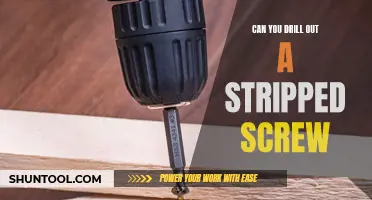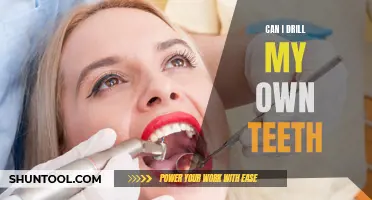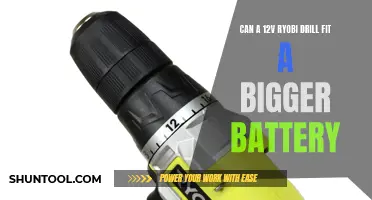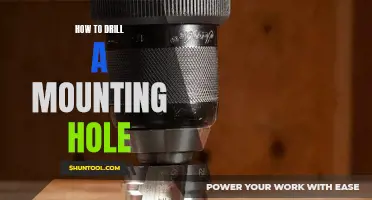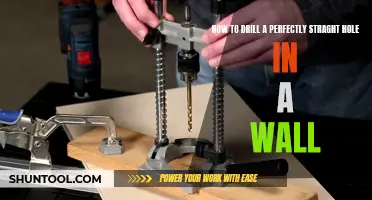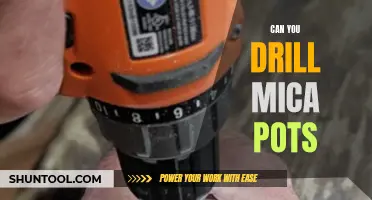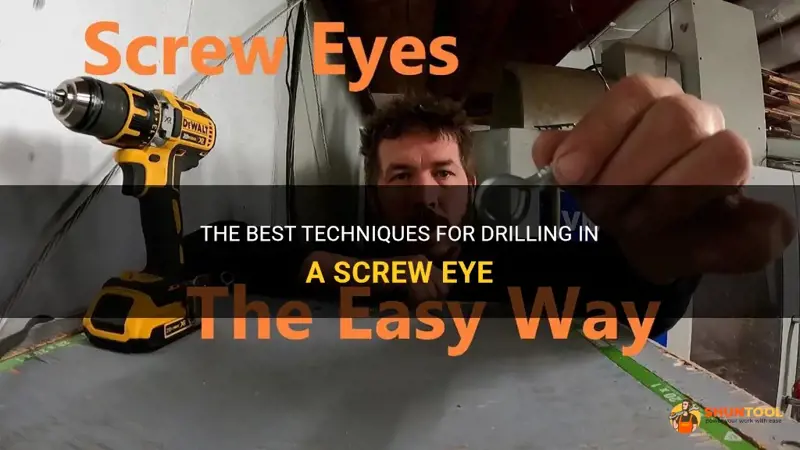
If you've ever been faced with the task of hanging a mirror, picture frame, or any other object on your wall, chances are you've encountered the need for a screw eye. These small, yet crucial hardware pieces can make all the difference in securely hanging your items. But, drilling a screw eye into a surface may seem daunting if you've never done it before. Fear not, as we're here to guide you through the process and have you hanging like a pro in no time. So grab your tools and let's dive into the world of screw eyes and drilling!
| Characteristic | Value |
|---|---|
| Material | Metal or hard plastic |
| Size | Varies (typically small) |
| Thread type | Coarse or fine |
| Shank length | Varies (typically short) |
| Shank diameter | Varies (typically small) |
| Head type | Round or flat |
| Head diameter | Varies (typically small) |
| Drive type | Screwdriver or drill |
| Pre-drilling | Required for hard materials |
| Torque | Varies (depends on screw) |
What You'll Learn
- What tools do I need to drill in a screw eye?
- What type of drill bit should I use for drilling into wood or metal?
- What is the proper technique for drilling a pilot hole before inserting a screw eye?
- How do I choose the right size screw eye for my project?
- Are there any safety precautions I should take while drilling in a screw eye?

What tools do I need to drill in a screw eye?
When it comes to installing a screw eye, having the right tools is essential to ensure a successful and efficient project. Screw eyes, also known as eye screws, are small metal devices with a loop on one end and a threaded screw on the other end. They are commonly used for hanging lightweight objects or for creating a point of attachment in various applications.
To drill in a screw eye, you will need the following tools:
- Power Drill: A power drill is a must-have tool for drilling holes in various materials. It provides the necessary speed and torque to create a hole effortlessly. Make sure to use a drill bit that matches the size of the screw eye you are using.
- Screw Eye: Choose a screw eye that suits your needs. They come in different sizes and materials, so select one that matches the weight and strength requirements of your project. For example, a small screw eye may be suitable for hanging lightweight artwork, while a larger one may be needed for suspending a plant basket.
- Pencil and Measuring Tape: Before drilling any holes, it is important to plan and mark the precise location where you want to install the screw eye. Use a pencil to make the necessary marks on the surface. A measuring tape can be helpful to ensure accurate placement.
- Safety Gear: When using power tools, it is important to prioritize safety. Wear safety goggles to protect your eyes from any debris or flying particles. Depending on the material you are drilling into, you may also need gloves or a mask to protect against dust or potential sharp edges.
Now that you have gathered the necessary tools, follow these step-by-step instructions to drill in a screw eye:
- Mark the Spot: Use a pencil to mark the exact location where you want to install the screw eye. Ensure the mark is centered and level, especially if you are planning to hang something that requires balance.
- Choose the Right Drill Bit: Select a drill bit that matches the size of the screw eye. It should be slightly smaller in diameter than the screw thread. This will help create a snug fit for the screw eye.
- Secure the Surface: If you are drilling into a hard surface like wood or metal, secure it firmly using clamps or a vice. This will prevent any movement or slippage while drilling.
- Start Drilling: With the drill bit securely attached to the power drill, position the tip of the drill bit at the marked spot. Apply gentle pressure and start drilling slowly. Keep the drill perpendicular to the surface to ensure a straight hole.
- Drill to the Desired Depth: Continue drilling until you reach the desired depth for the screw eye. This will depend on the length of the screw thread and the intended purpose.
- Insert the Screw Eye: Once the hole is drilled, remove the drill bit from the power drill. Take the screw eye and align it with the hole. Begin turning it clockwise into the hole. Apply moderate pressure, but avoid over-tightening, as it may damage the material or weaken the hold.
- Verify Stability: After inserting the screw eye, check its stability by gently pulling on it or applying some weight to it. Ensure it is securely attached and can support the intended load.
By following these steps and using the right tools, you can easily and effectively install a screw eye for your specific project. Whether you are hanging a picture frame or creating a hanging display, having the right tools and technique will ensure a successful outcome.
The Safest Methods for Drilling a Screw - Your Step-by-Step Guide
You may want to see also

What type of drill bit should I use for drilling into wood or metal?
When it comes to drilling into different materials, it is important to choose the right drill bit for the job. Using the wrong drill bit can lead to inefficient drilling, damage to the material, and even injury. In this article, we will discuss what type of drill bit you should use for drilling into wood or metal.
Drilling into Wood
When drilling into wood, the most common type of drill bit to use is a twist bit. Twist bits are versatile and can be used for various applications. They have a pointed tip and flutes along the body, which help to pull chips out of the hole as you drill. Twist bits are available in various sizes, so you can choose the size that matches the diameter of the hole you need.
For larger holes, you may want to use a spade bit or a hole saw. Spade bits have a wide, flat cutting surface and are ideal for drilling holes up to 1.5 inches in diameter. Hole saws, on the other hand, have a cylindrical shape with teeth around the edge. They are suitable for drilling larger holes, typically ranging from 1.5 inches to 6 inches in diameter.
If you are drilling into very hard or dense wood, such as hardwood, you may want to consider using a brad point bit. Brad point bits have a sharp point and two scoring spurs that help to create a clean entrance hole and reduce tear-out.
Drilling into Metal
When it comes to drilling into metal, the drill bits you use will depend on the type of metal you are drilling into. For drilling into softer metals, such as aluminum or brass, a standard twist bit can be used. However, for harder metals, such as steel or cast iron, you will need to use a specialized drill bit.
For drilling into steel or cast iron, a cobalt drill bit is recommended. Cobalt drill bits are made from high-speed steel with added cobalt, which makes them extremely hard and durable. They can withstand the heat generated from drilling into hard metals and will last longer than standard drill bits.
In addition to cobalt drill bits, there are also carbide drill bits available for drilling into hardened steel or other extremely hard materials. Carbide drill bits have a tungsten carbide tip that is capable of drilling through tough materials without dulling or breaking.
It is important to note that when drilling into metal, you should always use cutting oil or lubricant to reduce heat and prolong the life of the drill bit. This will also help to ensure a smoother drilling process and prevent the bit from getting stuck.
In conclusion, choosing the right drill bit for the job is crucial for successful drilling into wood or metal. For wood, twist bits, spade bits, and hole saws are commonly used, depending on the size of the hole. For metal, cobalt or carbide drill bits are recommended, depending on the hardness of the material. By using the correct drill bit and following proper drilling techniques, you can achieve clean and precise holes in your desired material.
Do You Really Need a Hammer Drill for Working with Cinder Blocks?
You may want to see also

What is the proper technique for drilling a pilot hole before inserting a screw eye?
Drilling pilot holes before inserting screw eyes is an essential step to ensure a strong and secure connection. A pilot hole is a small-diameter hole drilled into a material before inserting a screw or fastener. This article will provide a detailed guide on the proper technique for drilling pilot holes before inserting a screw eye.
Choose the Right Size Drill Bit:
The size of the pilot hole should match the diameter of the screw eye's body, excluding the threads. It is crucial to select the appropriate size drill bit to create a pilot hole that provides sufficient grip for the screw, while allowing it to penetrate smoothly.
Mark the Pilot Hole Location:
Before drilling the pilot hole, mark the exact location where you want to insert the screw eye. Use a pencil or marker to make a visible mark or create a small indentation with a center punch to guide the drill bit.
Prepare the Material:
Ensure that the material you are drilling into is clean and free from any debris or obstacles. For softer materials like wood, you can use a countersink bit to create a slight recess around the pilot hole to allow the screw eye to sit flush with the surface.
Secure the Material:
If possible, secure the material in place using clamps or a vise. This will prevent it from moving or rotating during the drilling process and ensure accurate placement of the pilot hole.
Start Drilling:
Insert the appropriately sized drill bit into the chuck of your drill. Align the drill bit with the marked pilot hole location and hold the drill perpendicular to the surface. Apply steady pressure and start drilling at a low speed.
Control the Depth:
Drill the pilot hole to a depth slightly longer than the length of the screw eye's body. This will allow the screw eye to embed securely in the material without protruding too far or causing damage.
Remove the Drill Bit:
Once you have reached the desired depth, slowly withdraw the drill bit from the pilot hole. This should be done carefully to avoid damaging the surrounding material or causing any splintering.
Clean the Pilot Hole:
After drilling the pilot hole, clean out any debris or sawdust that may have accumulated in the hole. This can be done by blowing compressed air or using a brush to ensure a clean and smooth surface for the screw eye to be inserted.
Insert the Screw Eye:
Align the screw eye with the pilot hole and slowly insert it by hand. Turn the screw eye clockwise while applying gentle pressure until it is fully embedded in the material. Avoid overtightening, as it may cause the material to split or weaken the connection.
Test the Connection:
Once the screw eye is fully inserted, give it a gentle tug or apply a small amount of force to test the strength of the connection. If the screw eye feels secure and does not move or loosen, the pilot hole has been properly drilled.
In conclusion, drilling a pilot hole before inserting a screw eye is essential for creating a strong and secure connection. By following these step-by-step instructions and using the proper technique, you can ensure that the screw eye is securely embedded in the material, preventing any potential damage or failure.
The Best Techniques for Securing a Screw While Drilling
You may want to see also

How do I choose the right size screw eye for my project?
Choosing the right size screw eye for your project is important to ensure a secure and hassle-free installation. Whether you are hanging a picture frame, attaching a hook for a hanging planter, or any other task that requires a screw eye, following these steps will help you make the right choice.
- Determine the load capacity: The first step in selecting the right size screw eye is to determine the load capacity it needs to support. This will depend on the weight of the object you are hanging or attaching. It's always better to choose a screw eye with a higher load capacity than you think you will need to ensure it can withstand the weight over time.
- Consider the material: Screw eyes come in various materials, such as stainless steel, brass, and zinc-plated steel. Choose a material that is suitable for your project's needs. For example, if you are hanging something outdoors, stainless steel or zinc-plated steel screw eyes are recommended for their corrosion resistance.
- Measure the diameter: The diameter of a screw eye refers to the thickness or width of the screw shaft. Measure the hole or opening where you plan to insert the screw eye and choose a diameter that fits snugly. It is essential that the screw eye fits securely in the hole to prevent any accidents or damage.
- Determine the length: The length of the screw eye is another important factor to consider. It should be long enough to securely fasten the object you are hanging or attaching. If the screw eye is too short, it may not hold the weight properly, leading to potential accidents or damage. Measure the depth of the hole and add extra length to ensure a secure attachment.
- Consider the threading: Screw eyes come in different threading options, such as wood threading, machine threading, or self-tapping. The threading type you choose will depend on the material you are screwing the eye into. For example, wood threading is suitable for wood surfaces, while self-tapping threading is ideal for metal surfaces.
Example:
Let's say you want to hang a mirror that weighs approximately 30 pounds. You have a wooden wall where you plan to attach the screw eye. Following the steps above, you would:
- Determine the load capacity: Knowing that your mirror weighs 30 pounds, you should choose a screw eye with a higher load capacity, such as one rated for 40-50 pounds, to ensure stability and safety.
- Consider the material: In this case, you can choose a screw eye made of brass, stainless steel, or zinc-plated steel, as they will all provide adequate strength and durability for your project.
- Measure the diameter: Measure the hole or opening in the wooden wall and choose a screw eye with a diameter that fits snugly. For example, if the hole measures 1/4 inch, choose a screw eye with a 1/4-inch diameter.
- Determine the length: Measure the depth of the hole and add extra length to ensure a secure attachment. If the hole is 1 inch deep, you may want to choose a screw eye that is 1.5 or 2 inches long.
- Consider the threading: As you are attaching the screw eye to a wooden surface, you will want to choose a screw eye with wood threading to ensure a strong and secure attachment.
By following these steps and considering the specific requirements of your project, you can confidently choose the right size screw eye that will provide a secure and long-lasting installation for your task. Remember to always prioritize safety and choose a screw eye with a higher load capacity than you think you will need to ensure durability and stability.
Are Deck Screws Self-Drilling? Find Out Here
You may want to see also

Are there any safety precautions I should take while drilling in a screw eye?
Drilling in a screw eye can be a simple task, but it is important to take the necessary safety precautions to prevent injuries and accidents. Here are some safety measures you should consider before and while drilling in a screw eye:
- Wear safety gear: Always wear safety goggles to protect your eyes from any potential flying debris or dust. Additionally, wear gloves to protect your hands from splinters or sharp edges.
- Choose the right tools: Use the appropriate drill bit size for your screw eye. Using a larger drill bit can cause the screw eye to not fit securely, while using a smaller drill bit can damage the surrounding material. Ensure that your drill is in good working condition and take the time to familiarize yourself with its functions.
- Pre-drill pilot holes: Pre-drilling pilot holes can make it easier to insert the screw eye. Choose a drill bit size that is slightly smaller than the diameter of your screw eye to ensure a snug fit. This will also reduce the chance of the material splitting or cracking when the screw eye is inserted.
- Secure the material: It is important to securely fasten or clamp down the material you are working on to prevent any movement or slipping. This will provide more control while drilling and minimize the risk of accidents.
- Check for obstacles: Before drilling, ensure that there are no electrical wires, pipes, or any other obstructions hidden behind the material. Using a stud finder or a similar device can help detect any potential obstacles that could be damaged during drilling.
- Take breaks: Drilling can be a physically demanding task, especially if you are working on a large project. Take regular breaks to rest and hydrate to prevent fatigue and maintain focus.
- Use controlled force: Apply controlled force when drilling in the screw eye. Excessive force can cause the drill to slip, potentially resulting in injuries. Let the drill do the work and avoid pushing or forcing it.
- Clean up debris: After drilling, clean up any debris or dust that may have accumulated around the work area. This will help maintain a safe and clean workspace, reducing the risk of accidents or falls.
By following these safety precautions, you can ensure a safe drilling experience while installing a screw eye. Remember to always prioritize safety and take your time to complete the task carefully.
Transforming Your Impact Drill into a Versatile Hammer Drill
You may want to see also
Frequently asked questions
To drill a hole for a screw eye in wood, start by marking the spot where you want to place the screw eye. Use a ruler or measuring tape to ensure accuracy. Next, select a drill bit that matches the diameter of the screw eye's shank. Place the drill bit in your drill and align it with the marked spot on the wood. Apply gentle pressure as you drill, making sure to keep the drill bit perpendicular to the surface. Once the hole is drilled to the desired depth, you can then insert the screw eye and tighten it in place.
Using a pilot hole when installing a screw eye is highly recommended, especially when working with hardwood or dense materials. A pilot hole serves as a guide for the screw eye to prevent the wood from splitting or cracking during installation. It also makes it easier to drive the screw eye in straight and ensures a secure fit. To create a pilot hole, use a drill bit slightly smaller in diameter than the screw eye's shank and drill a hole to the desired depth before installing the screw eye.
While it is possible to install a screw eye without a drill, using a drill is generally the most efficient and effective method. If you don't have a drill, you can try using a hammer and a nail or a screwdriver to create a starter hole for the screw eye. However, keep in mind that this method may require more effort and can be less precise. Additionally, without a drill, it may be challenging to achieve the desired hole depth, which could impact the stability and effectiveness of the screw eye once installed.


